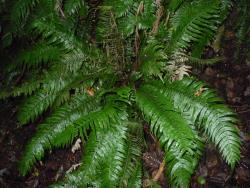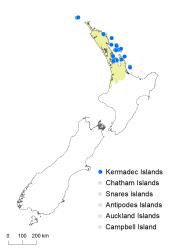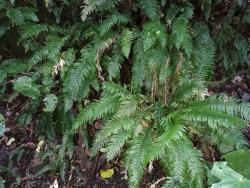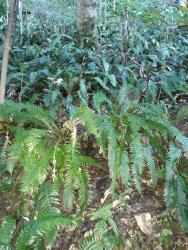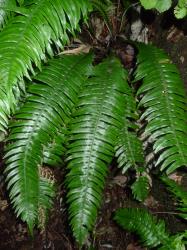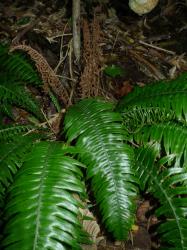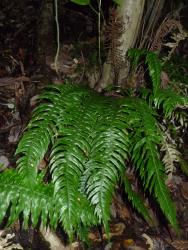- ≡ Lomaria norfolkiana Heward, London J. Bot. 1: 122 (1842)
- ≡ Blechnum lanceolatum var. norfolkianum (Heward) Domin, Biblioth. Bot. 20(85): 13 (1913)
- ≡ Austroblechnum norfolkianum (Heward) Gasper & V.A.O.Dittrich in Gasper et al., Phytotaxa 275: 203 (2016)
- = Lomaria acuminata Baker in Hooker & Baker, Syn. Fil., ed. 2. 481 (1874) nom. illeg., non Lomaria acuminata Desv. 1811
Rhizomes erect, up to 80 mm long (in herbarium material), bearing scales. Rhizome scales linear to narrowly ovate, 5–15 mm long, 0.4–0.8 mm wide, dark brown, concolorous. Fronds strongly dimorphic; sterile fronds 300–800 mm long, or rarely only 230 mm long, arching outwards; fertile fronds on the same plant usually a little shorter, 230–550 mm long, or rarely only 200 mm long, positioned centrally, held ± erect. Sterile fronds. Stipes 20–140 mm long, red-brown, bearing a few scales proximally. Rachises yellow-brown, grooved adaxially, glabrous. Laminae 265–700 mm long, 70–250 mm wide, or rarely only 55 mm wide, deeply pinnatifid to pinnatisect, narrowly elliptic to narrowly obovate, with a short apical segment, dark shiny green on both surfaces, thick and coriaceous, glabrous. Pinnae in 25–58 pairs, closely spaced, narrowly oblong, often broadened proximally, slightly falcate, gradually reducing to short oblong or triangular flanges at the lamina base; the longest pinnae at or above the middle, 50–125 mm long, or rarely only 30 mm long, 8–16 mm wide, apices acuminate, margins shallowly crenate, bases adnate; the basal pinnae alternate. Veins free. Fertile fronds. Stipes 30–180 mm long. Laminae (110) 150–500 mm long, (30) 50–190 mm wide. Pinnae in (25) 30–47 pairs, linear, straight, (16) 25–100 mm long, 1–2.5 mm wide, reducing to tiny sterile flanges at the lamina base. Sori and indusia in one row either side of costa, continuous along the length of the pinna.
Note: Small sizes given in brackets are from plants collected on the Mokohinau Islands (CHR 111656).
Blechnum norfolkianum is distinguished by its dimorphic fronds, free veins, pinnatisect sterile laminae, and continuous sori. The sterile laminae are narrowly elliptic to narrowly obovate, with narrowly oblong pinnae that are acuminate at their apices, shallowly crenate on the margins, and adnate at their bases. The basal pinnae are alternate. The laminae are glabrous, of similar colours on both surfaces, and are never tinged red. The sterile fronds surround the fertile fronds, which are held upright in the centre, the fertile usually a little shorter than the sterile.
B. norfolkianum is very similar to B. chambersii, differing principally in its larger fronds, wider laminae, shiny green colour, more acuminate pinna apices, and oblong basal flanges. In B. chambersii the sterile laminae are 15–115 mm wide and the longest pinnae 14–60 mm long, compared to 70–250 mm wide and 50–125 mm long in B. norfolkianum. The fertile laminae are 10–70 mm wide, and the longest pinnae 5–40 mm long in B. chambersii, and 50–190 mm wide and 25–100 mm long in B. norfolkianum. The lamina length:width ratio is c. 3–5:1 in sterile fronds and c. 2–5:1 in fertile fronds of B. norfolkianum, compared to ratios of c. 4–6.5:1 and c. 5–10:1, respectively, in B. chambersii.
Occasional aberrant forms are found with mixed fertile and sterile pinnae on the same frond.
North Island: Northland, Auckland.
Kermadec Islands, Three Kings Islands.
Altitudinal range: 0–600 m.
Blechnum norfolkianum occurs on the Kermadec Islands, Three Kings Islands and several of the Hauraki Gulf islands as far south as Mayor Island. It grows from near sea level, up to 600 m on Little Barrier Island. It is not known with certainty from the mainland, except for two collections from Whitford, Hunua Ranges (AK 296885) and Castle Rock, Coromandel (AK 161377). It has also been recorded from the Chatham Islands (de Lange et al. 2011), but its presence there requires further investigation; most collections appear to be large forms of B. chambersii, but a few approach B. norfolkianum (e.g. AK 298382).
Also Norfolk Island and Vanuatu (Nakamura 2008).
Blechnum norfolkianum is found in kauri forest, coastal broadleaved forest, and under coastal scrub, growing on cliffs, clay banks, in rock crevices, on streamsides, in gullies, or on the forest floor.
Blechnum norfolkianum was given a conservation status of At Risk/Naturally Uncommon by de Lange et al. (2018).
It is likely that Blechnum norfolkianum hybridises with B. chambersii on offshore islands where the two species frequently occur together, and where the two species are sometimes hard to distinguish (see Chambers & Farrant 1998). However, no sign of spore abortion has been seen in plants of intermediate morphology, and conclusive evidence of hybridisation is lacking.
2n = c. 66 (Chambers 1954).
In some earlier New Zealand Floras this species was misidentified as Lomaria attenuata (Sw.) Willd.
Green (1994) included Samoa and the Society Islands in the distribution of this species, probably on the basis of misidentifications. The occurrence of this species outside New Zealand and Norfolk Island needs confirmation.
DNA sequences from Blechnum chambersii and B. norfolkianum are identical (Shepherd et al. 2007), indicating that they are very closely related. Further work is needed to establish the genetic evidence for their distinctiveness.



